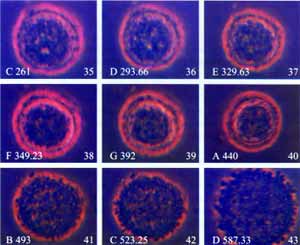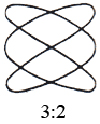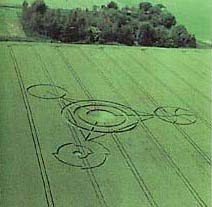SCIENTIFIC RESEARCH
Fabien Maman
In 1974 Fabien Maman was working as a jazz guitarist. During a concert tour with his group in Japan, he noticed that at the end of each piece the audience didn't clap. They would clap only at the end of the concert. The silence after each piece bewildered him at first but after the initial apprehension he began to anticipate and even enjoy the silence.
In the silence he began to feel the effect that each piece of music had on him. He noticed that after a concert he had more energy. After three months of touring Japan, Maman realised that clapping in between pieces was actually destroying some of the benefits of the music.
Fabien noticed that certain musical keys had an energising effect on both the musicians and the audience. The same piece of music played in a different key or at a different time of year had a different effect.
In 1981 Fabien Maman met Hélène Grimal, a senior researcher at the National Centre for Scientific Research in Paris. She was interested in the effects of music on human cells. Through their friendship, Maman and Grimal were able to devote a year and a half to a study of the effects of sound on cancer cells.
They went to the University of Jussieu in Paris five nights a week for a year and a half, carrying out their experiments at night in the biological research laboratories. They had to wait until the subway stopped for the night so that its vibration wouldn't affect their experiments. They experimented with healthy blood cells, haemoglobin, and cancer cells.
Cancer Cells
In the first experiments they mounted a camera on top of the microscope to photograph the inside structure of each cell as it reacted to the different sounds they produced. In the second group of experiments they used Kirlian photography in order to record the changes in the electromagnetic field of the cells as they received the sounds. (Kirlian photography shows the subtle energy field around living things).
In the course for their investigation, they took thousands of pictures. The sound was produced at a distance of 30 centimetres from the cells, at an amplitude of 30 to 40 decibels. Even though this is very quiet the sound always produced noticeable changes in the cells. As the sounds progressed up the musical scale there would be an 'explosion' of the cancer cells at a certain frequency as the sound travelled outward from the centre of the cell to its outer membrane.
Using drums, gongs, flutes, guitar, bass, xylophone and the human voice, they investigated the effects of sound on normal and malignant cells.
Fabien says, "I used the tempered scale and sounded the chromatic intervals one note at a time at a distance of thirty centimetres from the cell. The experiment yielded the most dramatic results when I used the human voice and the musical scale. The combination of the human voice and the musical scale caused the Hela cancer cells to explode more rapidly and predictably." (See photographs below). (Maman, 1997, p61).

Hela cancer cells being broken up by the musical scale played on a xylophone (6)
The French physicist Joel Sternheimer says that elementary particles behave as if they were musical notes on the chromatic scale. Fabien says that the explosion in the cancer cells is caused by the resonance between the sounds that we create and the elementary particles contained in the cell.
“The accumulation of all the sounds of the musical scale created an intolerable dissonance that broke up the cancer cells." (Maman, 1997, p61).
Maman and Grimal found that at sound frequencies between 'A' at 440Hz and 'B' 493Hz the cancer cells would break down, their structure thrown into complete disorganisation. The healthy cells, however, remained intact or became stronger. He says,"The healthy cells appeared supple and able to freely receive, absorb and return the energy. In contrast, the cancer cells appeared inflexible and immutable in their structure." (Maman, 1997, p90).
Healthy Cells
Fabien Maman took healthy blood cells and played a xylophone to them. He photographed the changes in the electromagnetic fields around the cells using Kirlian photography.
Subjected to a chromatic scale, the energy field around the blood cells changed its shape and colour. The colour produced in the energy field of the cells was affected more by the frequency of the sound, while the quality of the sound influenced the shape of the cell's energy field. A slight difference of half a tone would produce a completely different shape and colour in the energy field of the cell.
He found that the note 'C' made the energy field around the cells longer, 'D' produced a variety of colours, 'E' made the field spherical and 'A' (440Hz) changed the colour from red to pink.

Blood cells responding to the sound of a person's voice
Fabien says about the note 'A' (440Hz), "Thus, A 440 is a powerful sound of harmonisation. This Indian pink colour which can be seen in the picture always appears when A 440 is played, no matter what instrument is used. Pink is generally acknowledged as the colour of love. (Maman, 1997, p73). (See photographs above)
In his next experiment, Fabien took a sample of blood from a person's finger. He asked the person to sing to their blood cell. Then he photographed what happened to the blood cell when the person sang the seven notes of the Major scale.
With each note the cell's energy field changed its shape and colour. When the person sang an 'F' to their own blood cells, the cells resonated perfectly with the voice, producing a balanced round shape and vibrant complementary colours of magenta and turquoise. (Maman, 1997, p73). (see photographs above).
Hans Jenny
In the 1960's a Swiss scientist called Hans Jenny spent over ten years conducting experiments to discover the effects of sound waves on materials such as glycerine, mercury, gel, liquids, powders and iron filings. Jenny used modern technology to construct a 'Tonoscope', an instrument which would produce a picture of the patterns sound creates in these different materials.
Jenny would send electronically produced sound through oscillating crystals to vibrate the metal plate on which different materials were placed. Jenny called his study 'cymatics,' from the Greek word 'kyma' which means 'wave'.
Different sounds would produce different patterns. As the sound frequency was increased these simple forms would break up and more complex patterns would appear.
Jenny observed how sound vibration created geometric shapes. A low frequency sound produced a simple circle, whereas a higher frequency increased the number of concentric rings around a central circle.
In his book 'Secrets in the Fields' Freddy Silva says, "Many of the vibrational patterns found in Jenny's photos mimic crop circle patterns. These include the circle surrounded by concentric rings, the tetrahedron at Barbury Castle in 1991 (see below), the spider's web mandala at Avebury from 1994 and the highly structured star fractals of 1997. Other photos demonstrate geometry within the crop circles' pattern.”
The Times reported on the 18th June 2008 that a Wiltshire crop circle contained the symbolic code for first ten places of pi (see below).
“Mathematicians are stunned by a new crop circle which apparently represents a perfect coded image of a complex equation.”
“The circle is, apparently, a coded image representing a complex mathematical number - the first ten digits of pi - and even astrophysicists admit they find it "mind-boggling".”
“The circular pattern was created in a barley field near Barbury Castle, an Iron Age hill fort, earlier this month. Measuring around 46m (150ft) in diameter, it has had crop circle enthusiasts and experts stumped.”
“The symbol was identified eventually by Mike Reed, a retired astrophysicist who contacted Lucy Pringle, a crop circle photographer and expert, with an explanation.”
“Maths codes and geometric patterns have long been an important factor in crop circle formations - one of the most famous formations ever created showed the image of a complex set of fractals known as The Julia Set, in a field near Stonehenge, 12 years ago.”
('Wiltshire crop circle identified as symbolic code for first ten places of pi'- The Times June 18th, 2008)
Whale and Bird Song
Recent research by scientists in America has revealed how musical intervals are found in whale song and bird song. They analysed the calls of humpback whales and birds as well as sounds of amphibians and insects.
The scientists found that, "The recordings of whale songs, speeded up about fourteen times, sound amazingly like bird songs. Indeed this whale music is said to be surprisingly beautiful, something like the sounds of oboe, muted cornet and bag pipes. As with bird songs, humpback songs follow specific musical rules.”
“The main differences between bird songs and their whale counterparts is that the former usually last only a few seconds while humpback songs last from about ten minutes to half an hour. Moreover birds typically rest between songs. Whales on the other hand may sing and re-sing their songs for many hours on end. ”
“An examination of bird song reveals a similarity with human music. There are interval inversions, simple harmonic relations, and retention of melody with change of key. Some birds pitch their songs to the same scale as Western music.”
The researchers note: "Even though they are capable of singing over a range of at least seven octaves, humpbacks use musical intervals between their notes that are similar to or the same as the intervals in our scales. Most surprisingly, humpback songs contain repeating refrains that form rhymes. This suggests that whales use rhyme in the same way that we do: as a mnemonic device to help them remember complex material.”
“Over a season, whales gradually change their song. Since all sing the same song, they must all agree on the modifications. After a rest of about six months, the whales burst forth into song again and all remember the old song, even without practice over that long interval. Their memories must be phenomenal. Now however, as they begin to sing again, the humpbacks change the details. After several seasons, the song is completely different.”
("Enhanced: The Music of Nature and the Nature of Music - Science AWI Quarterly, 2001")
Human Proportions and Musical Ratios
Leonardo Da Vinci studied of the proportions of the male human body as described in a treatise by the Ancient Roman architect Vitruvius.
1.A man's height is four cubits (and thus 24 palms).
2.A pace is four cubits.
3.The length of a man's outspread arms from finger tip to finger tip is equal to his height.
4.The distance from the hairline to the bottom of the chin is one-tenth of a man's height.
5.The distance from the top of the head to the bottom of the chin is one-eighth of a man's height.
6.The maximum width of the shoulders is a quarter of a man's height.
7.The distance from the elbow to the tip of the hand is one-fifth of a man's height.
8.The distance from the elbow to the armpit is one-eighth of a man's height.
9.The length of the hand is one-tenth of a man's height.
10.The distance from the bottom of the chin to the nose is one-third of the length of the head.
11.The distance from the hairline to the eyebrows is one-third of the length of the face.
12. The length of the ear is one-third of the length of the face.
The distance from the pubis to the feet compared to the overall height of the body creates the ratio 1/2 (the octave in music). The distance from the nipple to the feet compared with the overall height of the body creates the 3/4 ratio (the fourth interval in music).
All beautiful faces regardless of race, age, sex, and other variables conform to whole number ratios.
Reproduced from http://www.facialbeauty.org/divineproportion.html
References
Books
Doczi, G (1981) - The Power of Limits - Shambala Publications
Jenny, H (1974) - Cymatics Vol. 2 - Basel, Switz: Basilius Presse AG
Maman, F (1997) - The Role of Music in the 21st Century - Redendo Beach, Calif: Tama-Do Press
McClellan, R (1991) - The Healing Forces of Music - Shaftesbury, Dorset: Element
Silva, F (2002) -Secrets in the Fields - Hampton Road Publishing
Articles
Gray, P; Krause,B; Atema,J; Payne,R; Krumhansl,C and Baptista,L - Enhanced: The Music of Nature and the Nature of Music - Science AWI Quarterly, 2001 Vol. 49, No. 3.
Wiltshire crop circle identified as symbolic code for first ten places of pi - The Times, June 18th 2008.
Web Sites
http://www.facialbeauty.org/divineproportion.html








